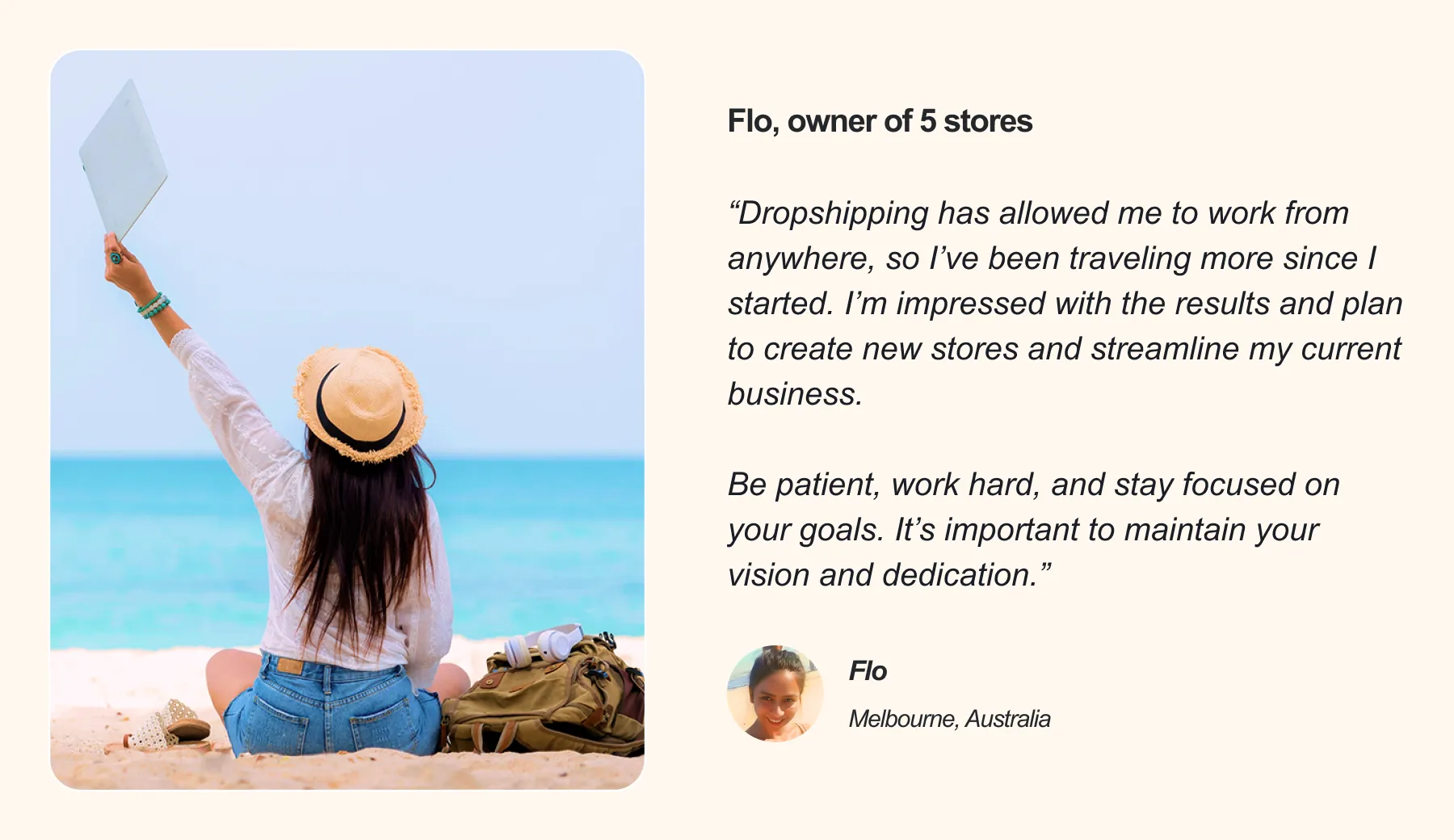What is ecommerce?
Discover what ecommerce is, explore its key models, and learn how to start earning from it.


What is ecommerce?
Ecommerce – short for electronic commerce – is the buying and selling of products or services over the internet.
It’s an umbrella term that covers:
- Physical goods (clothing, electronics, home essentials, etc.)
- Digital goods (online courses, eBooks, software)
- Services (consulting, coaching, design work)
If the payment happens online, it’s ecommerce.
Modern ecommerce is not just for big corporations or deep tech folks — it empowers everyday people reaching financial independence, even with no prior experience.
With the right toolkit, you can launch an online store in minutes, test products, and see what resonates.
That is why ecommerce is the go-to starting point: low stress, no debt, and the freedom to scale when you are ready.
The total continues to rise in 2025. Every niche has its audience — from fashion and sneakers to pet toys, beauty, gadgets, travel accessories, and more. Because the internet offers virtually unlimited shelf space, the opportunity is enormous, and sellers keep finding new ways to differentiate.
Main types of ecommerce
There are four core models:
- B2C (Business-to-Consumer)
- B2B (Business-to-Business)
- C2C (Consumer-to-Consumer)
- D2C (Direct-to-Consumer)
If you’re just getting started, the most fitting route is B2C (Business-to-Consumer).
This is the classic ecommerce play: when you sell directly to your customers. Imagine launching your own line of curated streetwear, a gadget shop, or a boutique on Amazon. It’s the go-to launchpad for a reason:
- You don’t need corporate clients or wholesale volumes – just everyday customers.
- Your potential audience is unlimited – everyone purchases something online.
- You can begin small, test products, and scale as you learn.
For instance, someone might kick off with trending sneakers, cozy home items, or beauty accessories. Each sale is simple: an order comes in, you ship it out. With tools like Shopify or Amazon handling the tech, you’re free to focus on what matters: building your brand.
Why do ecommerce?
Ecommerce has transformed business by stripping away physical boundaries.
Key advantages:
- Worldwide audience – Reach buyers worldwide without opening brick-and-mortar stores.
- 24/7 sales – Your shop never closes, so you can earn even while you sleep.
- Scalability – Expand quickly by adding products, entering new markets, or supporting multiple languages.
Ecommerce in 2025: Trends to keep in mind
To win, you need a clear view of where ecommerce is heading:
- Mobile-first – Most shoppers browse and buy on their phones.
- Social commerce – TikTok, Instagram, and YouTube are becoming full-fledged marketplaces.
- AI-driven personalization – Smarter recommendations boost conversions.
- Eco-conscious shopping – Sustainable brands build deeper loyalty.
- Faster delivery expectations – Same-day and next-day shipping are now baseline.
Today’s ecommerce gives all of this, making the process smooth for both customers and entrepreneurs.
How to start making money with ecommerce in 2025

Getting an online business in 2025 is one of the smartest moves you can make. It offers freedom: work from anywhere, sell products you believe in, and start without the high costs of a physical store.
Success isn’t about luck. It’s about a proven process.
This guide gives you that process. We’ll show you how to pick your first product, launch your store, and scale it into a a real business, transforming your idea into income faster than you think.
Step 1: Pick a niche
Your niche is the exact audience and product category you choose to sell to.
A well-chosen niche allows you:
- Stand out from generic stores.
- Speak to an excited audience.
- Make your marketing way more effective.
Examples:
- Baby products.
- Pet products.
- Travel accessories.
- Wellness and self-care products.
Step 2: Get winning products
Once you decided on your niche, it’s time to choose what to sell.
Avoid:
- Ultra cheap, low-quality products that will damage your brand.
- Too many seasonal products (unless you’re okay with big sales swings).
Go for:
- Products with stable demand.
- Items that address an issue or make life better.
- Products that are simple to ship.
Step 3: Launch a store
You could go two main ways:
- Craft it yourself using platforms like WooCommerce or Shopify
- Skip the tech matters and get a ready-to-sell store from AliDropship.
What a high-converting store needs:
- Sleek, mobile-friendly design.
- Top-tier product photos and descriptions.
- Easy checkout process
AliDropship delivers all of this instantly, as well as:
- Built-in product pages.
- Automatic order processing.
Step 4: Price for profit
Pricing isn’t about racing to the bottom – it’s about striking the right balance between value and profit.
Basic formula:
- Retail price = Wholesale cost + Desired profit margin
Example:
- Buy at $15 → Sell at $35 → $20 profit per sale.
Step 5: Market the store
Even the finest products won’t sell if no one sees them.
Beginner-friendly promo ideas:
- Social media posts showing products in use.
- Influencer collaborations with micro-creators in your niche.
- Paid ads on Facebook, Instagram, or TikTok.
- Content marketing (blog posts, videos, tutorials).
With AliDropship, your store can be promoted for you (with an auto-promotion service), so you don’t need to stress about anything.
Step 6: Scale your business
Once you’re making profits, focus on:
- Adding more products your customers will love.
- Refining your ads based on performance data.
- Expanding your channels – marketplaces, social shops, and beyond.
Because AliDropship constantly refreshes its catalog, growing your product line is as simple as clicking “add.” New, on-trend items are added regularly – keeping your assortment competitive and appealing.
10 tips to sell online successfully in 2025

Selling online in 2025 offers a unique opportunity.
More people are shopping from their phones, and the tools to start are incredibly accessible. But to find real success, you need a strategic approach.
The competition is fierce. You can no longer just list a random product and expect sales. Today’s winners stand out, build genuine connections with their audience, and manage their operations professionally.

The upside? You don’t need to figure everything out from zero. Below are 10 practical, beginner-friendly tips to help you not only launch but also grow a profitable store in 2025.
1. Choose the best products to sell
Your store’s success is in the products. With us, you don’t have to worry about choosing them.
AliDropship handles the research for you. We provide a curated catalog of high-converting products, combining current trends, timeless bestsellers, and emerging hits. Our team is dedicated to ensuring you always have access to competitive, standout items.
While others search for reliable suppliers, we have you covered. We succeed when you succeed.
2. Get a clean online store
First impressions matter. Research suggests visitors form an opinion about your site in ~0.05 seconds. If it feels dated, cluttered, or untrustworthy, they’ll bounce – even if your products are excellent.
Essentials of a solid store:
- Clean, modern design that reflects you
- Consistent colors and typography
- Clear, intuitive navigation and menus
- Mobile-friendly layout (more on that below)
- Fast loading – every extra second can hurt conversions
3. Make experience easy for your visitors
Your store shouldn’t feel like a maze. Every step from browsing to checkout needs to be smooth and simple. Ask yourself:
- Can customers find products within 3 clicks?
- Are shipping costs and delivery times clear before checkout?
- Is the payment flow quick and secure?
4. Looks are important
Online, your visuals are your salesperson. Remember: customers don’t just buy a product – they buy the experience it offers.
Move beyond basic product photos. Instead, show your product in action:
- Lifestyle images – a backpack on a mountain hike.
- Short demo videos – a gadget in action.
- Before-and-after visuals – home décor transformations.
5. Price with thought
Price too high, and you lose budget-conscious buyers. Price too low, and you hurt your profits and credibility.
The solution is competitive pricing backed by strong value. Enhance your offer with free shipping, product bundles, or exclusive bonuses to make customers feel they’re getting a great deal from your business.
6. Promote little by little
Many beginners try to do everything at the same time – launching ads on Facebook, Instagram, TikTok, Pinterest, and Google all at once. Instead of that, pick one or two platforms where your audience actually spends time, and master those first.
For example:
- TikTok – great for viral short videos if your products are fun, visual, or trend-driven.
- Instagram – ideal for lifestyle-heavy niches like fashion, beauty, or travel.
- Facebook – useful for precise demographic targeting and interest-based segments.
7. Optimize for mobile devices
Over 70% of ecommerce sales in 2025 are projected to take place on mobile devices. If your store isn’t mobile-optimized, you’ll lose a whole lot of money.
Key must-haves:
- Text and buttons sized for tapping.
- Fast load speeds.
- A checkout process designed for small screens.
8. Customer service is a must
Happy customers come back – and they bring friends. Great support turns one-time buyers into your own salesmen.
Ways to wow customers:
- Respond to messages quickly.
- Solve problems without blaming the customer.
- Follow up after purchases to say thank you.
9. Collect emails
Social algorithms change, ads get pricey, but your email list is yours forever. Send helpful content, special offers, and product updates consistently.
10. Keep going
The most successful stores are the ones that grow. Keep testing:
- New product variations.
- Different ad creatives.
- Seasonal offers and bundles.
- Copywriting styles in your product descriptions.
Track everything so you know what’s working – then do more of it.
What is ecommerce? [Answered]
Selling online in 2025 is exciting. The way to success isn’t about doing everything – it’s about doing the right things consistently.
That means:
- More time to market and connect with customers.
- Less stress over inventory and shipping.
- A quicker path to your first sale.
- The sooner you begin, the sooner you’ll see results.
The only thing between you and your first online sale is action – and you can take that step today.
If you're looking to start a side hustle and make extra money online, here are some resources to help you on your path to success.





